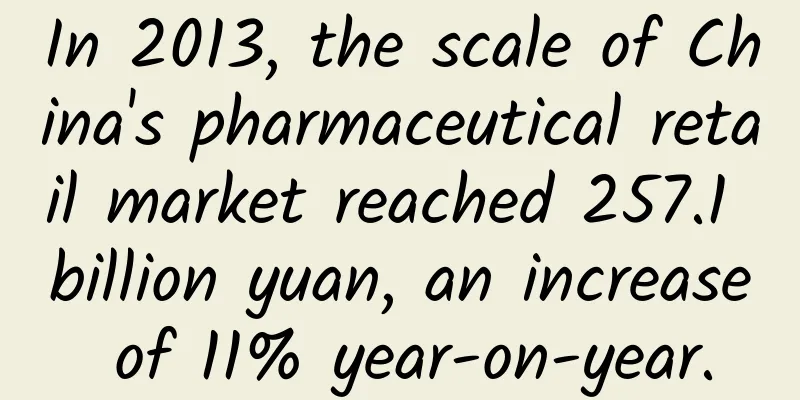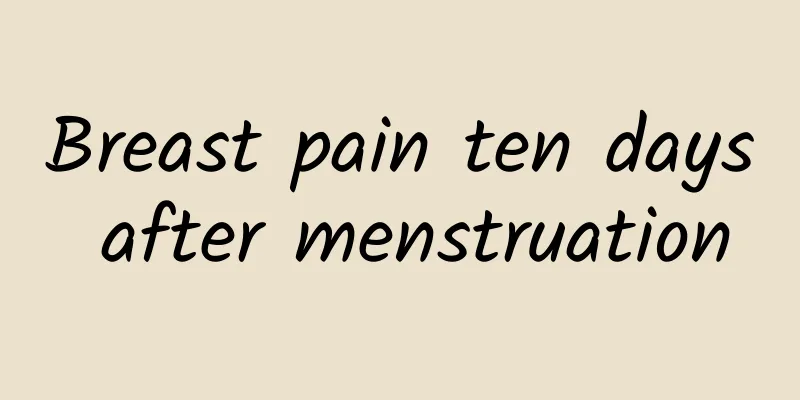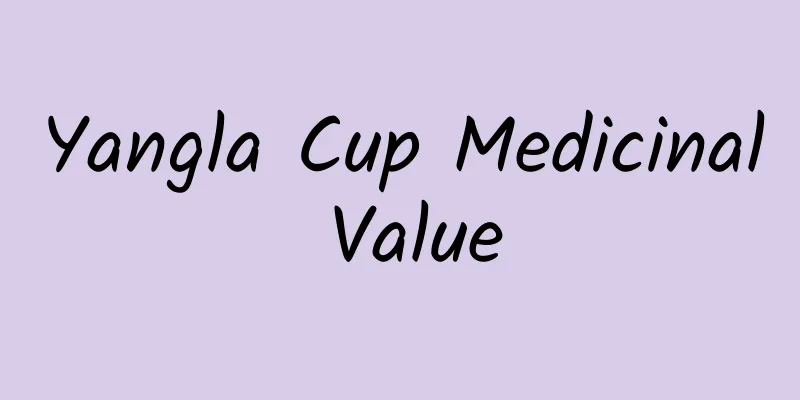In 2013, the scale of China's pharmaceutical retail market reached 257.1 billion yuan, an increase of 11% year-on-year.

|
In 2013, under the influence of a series of policies, the pattern of retail drugstores underwent some subtle changes in a calm state. The introduction and implementation of the new version of GSP accelerated the pace of drugstore chainization to a certain extent. From the perspective of the drugstore terminal sales market, the trend of sustained weak growth has reached a turning point. In response to the state's support and incentives for the development of the big health industry, the growth of non-drugs has rebounded, and the impact of the related supporting measures for milk powder is the most significant. The increase brought by this series of policies will further manifest in the next two years, and whether drugstore non-drugs can become a growth driver still depends on the further relaxation of policies and the determination of the entire industry. The impact of the new GSP is beginning to emerge According to the Blue Book, in 2013, the total number of pharmacies in China reached 442,314, an increase of 1.5% over 2012. Compared with the past, the growth rate of the number of pharmacies has slowed down significantly. According to the market visits of the competitiveness project team of "No. 1 Pharmacy", most regional markets are currently becoming saturated, and the problems of high store opening costs and long profit cycles have long appeared. Affected by this, the slowdown in the growth rate of store openings is understandable, and it can be seen that this impact is more obvious in first- and second-tier cities. In addition, in terms of policy, the suspension of approval for new store openings in some key cities due to regulatory needs has also curbed the rapid increase in the number of stores to a certain extent. With the promulgation of the new version of GSP last year and the implementation of the "two certificates in one", the threshold and cost of opening pharmacies have risen, which has undoubtedly increased the pressure to open stores. Of course, the new GSP has also accelerated the trend of retail pharmacies becoming chain stores to a certain extent. According to the Blue Book data, in 2013, there were 180,000 chain stores, with a chain rate of 42.8% and a direct chain rate of 28.8%, both of which increased compared with 2012. Moreover, the number of chain stores continued to grow, while the number of stand-alone pharmacies declined. Among the 180,000 chain stores, franchise stores account for 35%, and the growth of franchise stores is slightly faster than that of directly-operated stores. Some franchise stores join the chain system in order to pass the GSP certification. Therefore, there are still some problems with the standardization of its management. However, judging from the direct-operated chain rate alone, the situation in 2013 improved slightly compared with the sluggish development in the previous two years. Even so, it can be predicted that if there is no substantial growth in sales of pharmaceutical retail chains, a lack of policy support or poor policy implementation, it will be difficult for the industry's concentration to increase significantly in the next five years. It is worth mentioning that the concentration of chain drugstores in China is still very low. According to the survey results of the Blue Book, the sales scale of the top 100 in 2013 increased from 75 billion yuan in 2012 to 83 billion yuan, and the scale is expected to be 91.4 billion yuan in 2014. The sales of the top 100 direct stores accounted for less than 40% of the total scale, and the increase was slow. It is predicted that the proportion in 2014 will be around 38%, which is far from the target of 60% in 2015. In addition, the growth rate of the sales scale of the top 100 is significantly lower than that of the overall market. Among them, the impact from e-commerce and the operating pressure brought by the series of medical reform policies in the first and second-tier markets cannot be ignored. Milk powder sales gain momentum According to the Blue Book, in 2013, the scale of China's pharmaceutical retail market was 257.1 billion yuan, an increase of 11% over 2012, and the growth rate declined. In 2012, the figure was 13.25%. It is estimated that in 2014, the scale of China's pharmaceutical retail market will reach 280.5 billion yuan, and the growth rate will continue to slow down to only 9%. Of the total sales of 257.1 billion yuan, pharmaceuticals accounted for 79%, with sales of 202.1 billion yuan, up 12% year-on-year. Non-pharmaceuticals accounted for 21%, with sales of 55 billion yuan, up 8% year-on-year. Overall, the market share of pharmaceuticals increased by 1 percentage point compared with the same period in 2012, while that of non-pharmaceuticals decreased by 1 percentage point compared with the same period in 2012. From 2009 to 2013, the ratio of pharmaceuticals to non-pharmaceuticals remained at 8:2. Among the subcategories of non-pharmaceuticals, health products and medical devices are the largest, accounting for 70% of the total non-pharmaceutical market, but the market for these two categories is close to saturation, and the growth has slowed significantly. The food category is currently small in scale, but it is growing very fast and is the main driving force for the growth of the entire non-pharmaceutical market. Daily necessities and cosmetics continue to grow slightly. It is predicted that the growth rate of non-pharmaceuticals will be faster than that of pharmaceuticals in 2014, which is related to the growth of food categories driven by the introduction of milk powder business in drugstores. However, due to the strict control of card consumption of non-pharmaceutical categories in medical insurance designated drugstores in some cities, and the gradual withdrawal of cosmeceuticals brands from the drugstore market, the non-pharmaceutical category in the retail market will still maintain a relatively low share. In terms of share, it is expected that the share of health products will shrink slightly in 2014, while that of medical devices and food will continue to expand. Looking at the drug categories in pharmacies, the market share of chemical drugs and Chinese patent medicines is relatively stable, with chemical drugs accounting for 48%, Chinese patent medicines accounting for about 44%, and medicinal materials accounting for 8%. Although the scale of medicinal materials is small, the growth rate is considerable, and its growth momentum mainly comes from the rising prices of precious medicinal materials such as donkey-hide gelatin, cordyceps, and American ginseng. In 2013, the sales volume of OTC drugs reached RMB 108.9 billion, accounting for 55% of the market share, and the sales volume of RX drugs reached RMB 75.3 billion, accounting for 37% of the market share. The market size and growth rate of OTC drugs and RX drugs remained basically stable. The pattern of best-selling categories has changed The Blue Book data shows that in 2013, the sales share of the top 20 categories in the retail market accounted for 93%, and the market was highly concentrated. Cold medicines continued to hold the top spot in the category ranking, but gastrointestinal medicines and skin disease medicines faded out of the top three, replaced by cardiovascular and cerebrovascular and antihypertensive medicines. The growth rate of these two categories in 2012 was significantly faster than the overall market and other categories. It is estimated that in 2014, the share of cardiovascular and cerebrovascular, urinary and kidney-tonifying, and health-tonifying categories will increase significantly, and the growth rate will be significantly faster than the overall market and other categories; while the share of sedatives and nervous system drugs will decrease significantly, and the growth rate will be much lower than the overall level, and consumers will return to the hospital market to buy medicines. In 2013, the sales share of the top 20 manufacturers accounted for 30%, and the growth rate was basically consistent with the overall level. The advantages of large enterprises continue to emerge, and the advantages of foreign-funded enterprises are still obvious. The top five manufacturers are Guangzhou Pharmaceutical-Baiyunshan, Pfizer Pharmaceutical Co., Ltd., Bayer HealthCare Co., Ltd., China Resources Sanjiu, GSK and Johnson & Johnson. However, it is expected that the sales scale of GSK and Johnson & Johnson will decline in 2014. There are 10 foreign-funded enterprises in the top 20. In terms of growth, Dong-E-E-Jiao, Tong Ren Tang, Xiuzhen Pharmaceutical, Novo Nordisk and Shandong Fujiao are expected to grow significantly. In 2013, the top 10 categories of chemical drugs at retail outlets accounted for 72% of the total market share, and it is expected to continue to grow in 2014. Drugs for the treatment of chronic diseases are long-term market demand, and cardiovascular and cerebrovascular drugs will also maintain a relatively fast growth rate, which is the main driving force for the growth of chemical drugs. The top 10 categories of traditional Chinese medicines accounted for 87% of the total market share. It is predicted that tonic and health-preserving drugs will grow rapidly, driving the overall growth level of traditional Chinese medicines. |
<<: Analysis report on Korean inbound tourism in Beijing market
Recommend
The efficacy and function of scutellaria root
In modern life, everyone is very familiar with va...
Whoosh! Whoosh! Whoosh! How should spacecraft respond to micrometeoroids and space debris?
In December 2022, just as Russian astronauts Serg...
The efficacy and function of ginger peel
As for ginger peel, I think some people may have ...
Dunhuang murals have become "like crispy dough". How can restorers save this world treasure?
The topic of "How difficult is it to protect...
Childhood memories are not gone, we just can’t read them|Tech Weekly
Compiled by Zhou Shuyi and Pingsheng Why do anima...
The efficacy and function of red taro
The Chinese medicinal herb red taro is already ve...
How "empty" is an empty stomach? Can't you eat milk and bananas on an empty stomach?
In daily life, some activities must be performed ...
What are the effects of Panax notoginseng
With the continuous improvement of living standar...
Can lily be soaked in water and drunk?
Lily, as a flower with extremely high ornamental ...
How much is a pound of wild golden thread lotus
Wild golden thread vine is divided into natural w...
The more foam, the stronger the cleaning ability? Don't be fooled by advertisements anymore!
What factors do you usually consider when buying ...
Why do you feel less like moving the less you move? It may not be laziness! The "culprit" has finally been found
Reviewer of this article: Chen Haixu, Deputy Dire...
The efficacy and function of fresh bamboo sap oral liquid
Fresh bamboo sap puree and oil are a common thera...
The efficacy and function of chicken claw bark
There are so many medicinal herbs in the world, a...
What are the effects and ways to eat white wormwood?
In daily diet, Chinese chrysanthemum is a relativ...









